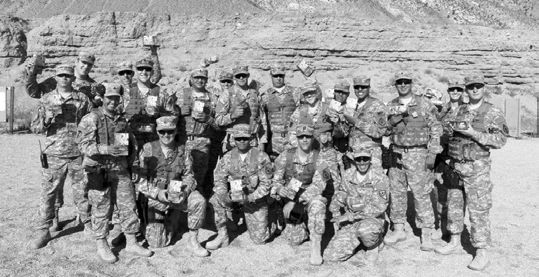Vincent Melillo stands by the vehicle he rode in during the Manchester, Ga. Veterans’ Day parade. Melillo, a recent inductee in the George Military Veteran’s Hall of Fame, was the grand marshal of the parade. (Courtesy photo)
It’s hard to imagine what the 3,000 men of the 5307 Composite Unit Provisional were thinking as they clambered off the S.S. Lurline in Bombay, India.
There were few of the trappings of modern warfare. There were no tanks, no trucks, no airplanes. Instead of modern transportation, the 5307 would rely on shoe leather and pack mules. Even heavy artillery was missing. The men instead had 60-mm mortar tubes.
It was Halloween, 1943, and much of the men’s future was unclear. All the men had answered then President Theodore Roosevelt’s call for volunteers to take up secret dangerous and hazardous missions. The 5307’s mission was especially hazardous.
The unit had orders to march through India and Japanese-occupied Burma to Myitkyina, the site of the only all-weather airport in the country. There was no plan for extraction — the 5307 was not expected to survive. The brass expected 85 percent casualties.
In their way stood the Himalaya Mountains, the rugged Burmese jungle, and the 18th Japanese Infantry Division.
The 18th Division was an old, veteran division. It was deployed to China in 1937, and had seen action against the Chinese during the Japanese invasion. In 1942 it transferred to Burma with 31,444 men.
Of the 3,000 American men who landed only a handful would survive to see the end of the campaign. Only two made it through the campaign without being hospitalized for wounds or illness.
“What stands the Marauders apart, however, was the fact they were operating in some of the toughest terrains imaginable, and one of the most disease infested,” said Gavin Mortimer, author, in a press release promoting his new book about Merrill’s Marauders. “That they defeated not only the Japanese, but also the multitude of diseases, is proof of their outstanding achievement.”
Among the men left standing at the end of the campaign was Vincent Melillo, a 95-year-old Georgia man with roots in Northern Nevada—two generations of his descendants live in Reno. But Melillo’s descendents aren’t the unit’s only link to Nevada. The El Capitan Resort and Casino played host to a handful of the marauders’ reunions.
The marauders set out for Burma on Feb. 24, 1944. Crossing behind Japanese lines, the 5307 marched around 1,000 miles—longer than any other American unit in World War II.
“We were completely supplied by air from C-47 transport planes, which kept us alive by dropping supplies to us, although sometimes we couldn’t get to the supplies,” said Melillo.
Days later, Melillo was part of a five-man patrol that met the Japanese, and suffered the unit’s first man killed in action. Melillo is the only surviving member of that patrol.
Melillo also saw significant action only a few weeks later as part of the 2nd Battalion, which was cut off and besieged by the Japanese for two weeks.
For his action in the face of the enemy, Melillo won the Bronze Star.
After eight months of hard fighting the Marauders took their objective, opening allied supply lines in Asia.
But the price was steep.
Of the nearly 3,000 men who had crossed behind Japanese lines only 200 were alive and well enough to help storm the airfield at Myitkyina. Replacements accounted for many of the 1,300 marauders at the airfield.
Of these, fewer than 300 were considered well enough to take part in the fighting for the airfield.
For its actions, the unit was awarded the Presidential Unit Citation, and each man was awarded the bronze star.
Mortimer, an Englishman who has written extensively on Special Forces operations in World War II, published his new book, “Merrill’s Marauders: The Untold Story of Unit Galahad and the Toughest Special Forces Mission of World War II,”, earlier this month.
Melillo, who is one of Mortimer’s sources, was evacuated from Burma with malaria and dysentery. He went on to earn two purple hearts and serve in the Korean War.
He was inducted into the Army Ranger Hall of Fame in July.


